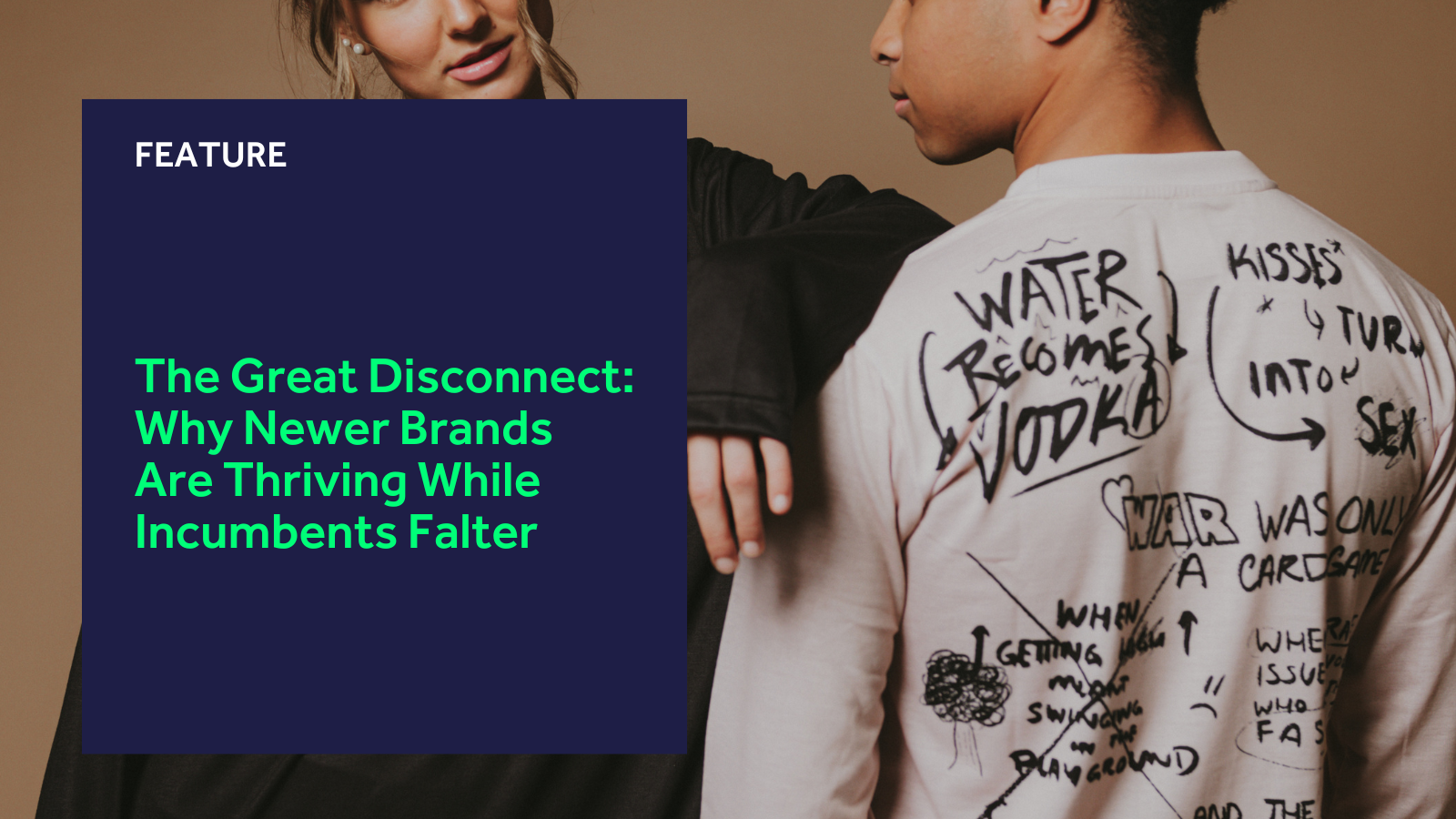We’re not about to boldly claim that corporate greed is destroying fashion from the inside out, but we are about to say that endlessly chasing profits is causing a disconnect between once unstoppable brands and their not-so-loyal-anymore customers.
No – this piece isn’t what you’re expecting. It isn’t a deep dive into brands pursuing profit before the planet (although that is a serious problem). Instead, we’re exploring how newer brands are swiftly taking over the market while established incumbents seem to be faltering.
Losing Touch: The Case of Nike
It’s ironic that an industry so laser-focused on delivering to the end consumer can so easily forget that the consumer is the very reason for its existence. Many brands remain true to their core, but with each passing year, they seem fewer and fewer. Nike is a prime example.
Nike is a behemoth, and despite the apparent disconnect with its core demographic, it isn’t disappearing overnight. Empires don’t vanish so quickly. But there’s no denying that Nike has taken a beating recently. Between betting on consumers not returning to physical stores and over-reliance on performance marketing, Nike’s perplexing last few years have shone a light on something critical: never forget your consumer.
Compare this to Nike’s competitors, Hoka and On. In the past, Nike had a strong foothold among runners and outdoor enthusiasts, but in trying to expand beyond this, it muddled its brand message. This allowed Hoka and On to dig their heels into distinct niches within the these markets by staying true to their core audiences – something that Nike abandoned.
Hoka, known for its maximalist cushioned designs, focused exclusively on comfort and performance. This differentiation allowed it to carve out its own space in the market without going directly into competition with industry titans. Ironically, though, innovation was once a key piece for Nike, and now it continues to lose sales while Hoka wins more.
Initially appealing to hardcore athletes, Hoka has attracted a wider audience and expanded into lifestyle products. But it didn’t stray from its core focus on high-performance products, ensuring it stayed connected to its consumers’ wants. This loyalty, combined with efficient demand-based production and a strong direct-to-consumer (DTC) strategy, allowed the brand to maintain its premium positioning, driving full-price sell-throughs while capturing market share.
Elsewhere, On gained popularity with its CloudTec cushioning technology and minimalist aesthetic. Similar to Hoka, On’s focus on performance, strategic marketing and collaborations strengthened its global market position. The brand’s emphasis on sustainability also resonated with eco-conscious consumers, allowing it to steal market share from legacy footwear brands.
Like Nike, Adidas has also faced its challenges, which have been proving difficult in recent years. In January 2023, the brand appointed ex-footballer Bjørn Gulden to spearhead a comeback. Gulden has since identified several key issues, like Adidas’ risk-averse nature and its shift too far into lifestyle branding.
The new strategy involves reconnecting with Adidas’ sporting roots, with basketball and North America at the heart of its focus. Much like Nike, the brand’s attempts to pivot away from its core consumer base left it vulnerable to emerging competitors – a course which has since been corrected.
The takeaway? Hoka and On are growing because they remain connected to their core audience. Nike and Adidas, by contrast, have suffered due to brand dilution, a lack of innovation, and abandoning key strategies.
Branding and Storytelling: Nike’s Missed Opportunity
A deeper issue for Nike lies in its shift away from storytelling marketing towards performance marketing. Storytelling marketing evokes emotion and creates a cultural connection — something Nike was once a master at.
It’s somewhat ironic because measuring and quantifying the ROI on performance marketing is much easier, but Nike isn’t your typical run-of-the-mill brand. It’s a cultural icon. It’s evocative. That’s why its storytelling was so powerful. Ditching it diminished the brand, undermining its price position and leading to countless unsold goods. In comparison, Hoka and On continue to drive full-price sales because their brands aren’t diluted and the value proposition is clear.
So why are Hoka and On growing while Nike’s stagnating – aren’t both deploying new tactics? It again boils down to the consumer. Hoka and On have tapped into the DTC channel because demand is there. They needed to expand. Nike, on the other hand, scaled back its channels by going all in on DTC and foregoing wholesale altogether. This was a fatal mistake.
It’s well known that DTC and wholesale each have their respective strengths and weaknesses, demanding that companies adopt a blended approach of the two. To be a competitive brand in today’s environment, you have to be where your consumers are… and it just so happens that because Nike’s presence in retail stores waned, it became just another option in an ever-growing marketplace with up-and-comers on the rise.
The point is that, like with all things, there is no one-size-fits-all approach. Hoka and On have stayed in touch with their consumers and made moves in the right direction in accordance with their wants and needs. Nike did the opposite.
To be clear, we’re not intentionally bashing Nike and negatively portraying the brand. It’s still the market leader in footwear and isn’t going anywhere anytime soon (particularly with the announcement that former exec Elliot Hill will take the reins in October 2024). Instead, we wanted to use the Nike story to illustrate our key message: newcomers are on the rise because they’re in touch with the core demographics, while legacy brands aren’t.
The Power of Brand Equity: AllSaints and Represent
Branding is an often-misunderstood concept. It’s not just a logo or a colour palette; it’s the foundation that drives a brand’s purpose and direction. Two brands that have demonstrated the power of strong branding are AllSaints and Represent.
AllSaints, celebrating its 30th anniversary this year, has maintained its brand equity by staying true to its core values while expanding its product lines to include fragrances, childrenswear (aptly named “SmAllSaints”), eyewear, and men’s tailoring. Importantly, though, unlike Nike – which decided to pull back on wholesale relationships – AllSaints did the opposite.
CEO Peter Wood recently said that the brand is pleased to be focused on growing wholesale, franchise, and licensing partnerships across the globe to reach more customers. It now trades in 27 countries and opened a new Netherlands-based distribution centre back in the summer to support future European growth plans. Focusing on these partnerships while investing in eCommerce has allowed AllSaints to offset declining physical retail sales and navigate challenging market conditions.
What is most key, however, is that, like On and Hoka, AllSaints maintained its profitability by reducing markdowns and focusing on full-price sales. It has considerable brand equity and is able to maintain its premium positioning, meaning that shoppers still happily pay for the products – even if it means cutting back on other purchases. This is something Wood himself has stated. It’s a tale as old as time and one we see frequently in luxury.
Historically, luxury brands have been immune to turbulent times due to a strong focus on brand. Neglecting to build brand equity has seen countless fall in recent years while their competitors resiliently march forward. Represent is a great example of this. As a relative newcomer, the brand has grown far beyond the UK by cultivating a loyal following through its exclusive, high-quality products and strong DTC strategy. Represent’s model is predominantly based on scarcity, though today, it occasionally re-opens the “vault” to provide access to older drops. By releasing limited-edition products, Represent creates urgency and exclusivity among consumers, which is especially pronounced in the streetwear and sneakerhead communities.
Crucially, Represent understood that the modern streetwear customer is evolving. As noted by Business of Fashion, the hypebeast culture of logo-heavy t-shirts and hoodies is fading, replaced by a more eclectic mix of items that reflect diverse subcultures and individualism. While wallets tighten during economic uncertainty, shoppers are moving beyond mere hype and seeking authenticity in their purchases. This shift plays into the hands of brands like Represent which prioritise community and quality over mass production and fleeting trends.
One of the driving factors behind Represent’s success is social media, where co-founders Michael and George Heaton have documented the brand’s journey. Through leveraging social channels, Represent has fostered a deeply loyal and fierce community that has only expanded with the 24/7 product lines. Designed to attract fellow running and gym enthusiasts, 24/7 has deepened the community aspect of Represent, while the premium clothing has ensured that it never deviated from its core values. You don’t have to browse the 24/7 section of the website for long to see that the branding screams Represent throughout.
The “premium” aspect is key. The merging of luxury with streetwear style is a growing trend worldwide but one that Represent has effectively conquered. The commitment to quality has allowed the brand to charge premium prices while appealing to fashion-conscious consumers who value durability and craftsmanship and seek to be part of a community.
Streetwear itself is increasingly offering young shoppers a gateway into luxury, with brands frequently setting up shop in high-end areas. JLL’s report recently revealed that brands like A Bathing Ape and Kith are opening stores in places such as Chicago’s Gold Coast and Malibu. Palm Angels, another major player in streetwear, has expanded to New York’s SoHo to provide yet another example. Clearly, the link between streetwear and luxury is only strengthening, and it will play an instrumental role in both segments’ evolution in the coming years.
Whether intentional or not, Represent’s endorsements by celebrities and musicians alike have significantly contributed to the brand’s appeal to younger generations. While the brand can and is worn by anyone, it is very prevalent within youth culture. The focus on quality and community also helps distinguish it from other brands popular in youth culture, like The North Face, Canada Goose, and Stone Island, which have certain stigmas attached. That’s not to say any of those brands are bad – they’re all great – but they attract a very different crowd, even among younger generations. Why? Branding. Represent is perfectly attuned to its target market, and the results speak for themselves.
This is where “the great disconnect” can be observed in fashion. More traditional, legacy brands are losing the attention of the youth, and this has a knock-on effect. While still global titans, Nike and Adidas haven’t innovated or branded enough to keep experiencing the growth they always have. They’re ceding market share to more agile, trend-focused competitors because of it. Need more proof? Just look at the luxury space.
Brands have noticed this shift and are responding by embracing a different strategy, that being collabs with streetwear brands. These partnerships aren’t just about aesthetics but are part of a broader response to a growing generational divide. Older consumers remain loyal to the classic ways, but younger demographics crave connection and community. Over the past decade, luxury brands have increasingly turned to collabs to tap into the cultural cachet and hype that resonate with younger people. That itself shouldn’t be surprising. Bain & Co estimate that by 2030, over 70% of global luxury spending will come from Gen Z and Millennials. These younger and more diverse audiences are reshaping what luxury means and how it’s accessed, necessitating strategic changes from brands in this segment.
This is why emerging labels like Represent are swiftly rising. Heritage brands may indeed still be performing relatively well, especially with affluent customers, but luxury on the whole is feeling the strain. HSBC’s ‘Cruel Summer’ report noted that the sector is facing its sixth-worst year in two decades with major players like Burberry, Hermès, and Prada seeing lower-than-expected growth. The industry is at a crossroads with many feeling fashion has become more about business than true creative expression. With falling sales, brands are now reassessing their strategies, hoping to reignite the balance between creative direction and commercial success. As Marcus Jaye at theindustry.fashion aptly said:
“Fashion had a feeling it was wandering through a creative desert, in a transition period from ugly sportswear and branded merchandise. It became more about the business, branding and money than the design. Hopefully, the balance can be readdressed. Falling sales has made many brands reassess their strategies, realising that strength stems from the creative direction and creative directors need time to realise their vision.”
It’s hard to deny Jaye’s sentiment. Fashion is very much in a state of flux but as Represent and AllSaints have shown, design doesn’t have to come at the cost of branding and business. It’s more a case that legacy brands have lost sight of what’s important. But as these relative newcomers have shown, there is a blueprint to follow that will allow them to recapture that connection with younger, trend-driven audiences.
The Disconnect with Youth Culture
We’ve talked about the importance of branding, but it’s worth noting that brand alone can only do so much. Innovation and remaining in touch with your core market are equally important, and often this can necessitate changes to the brand.
Millennials and Gen Z are no longer captivated by the preppy, logo-heavy designs that once defined legacy brands like Ralph Lauren and Tommy Hilfiger. (To clarify, these are still fantastic brands with tremendous heritage that will remain constants in the industry.) But younger generations gravitate towards brands offering exclusivity, community, and authenticity. Factors that the likes of Represent and AllSaints have excelled at.
Both Ralph Lauren and Tommy Hilfiger have built their reputations around a specific “American Dream” aesthetic, but in today’s globalised and diverse fashion landscape, the brands don’t feel as strong as they once did. Whether that will hamper the brands’ long-term endeavours is a different question. They are still popular in certain demographics. The point is not so much to pick apart these legacy brands but rather highlight that younger brands, like AllSaints, have been more agile in adapting to new cultural movements, diversifying their offerings beyond traditional apparel to capture more market share.
Many brands we’ve referenced have noticed the changing landscape and are actively exploring alternatives. Tommy Hilfiger, for instance, has incorporated more customer data and targeted marketing strategies in its pivot to become a lifestyle brand. But where it once stood as a beacon of pop culture, now stands the newcomers. The positive for legacy brands is that they have the prestige and resources to take short-term hits while they change course and adapt to the new consumer.
At the risk of sounding like a broken record, we’ll go back to Nike and Adidas. The footwear market has gone through some major shifts in the last few years. It isn’t just Hoka and On that have gained momentum; brands like Salomon and Asics have ascended, too. Salomon’s resurgence can largely be attributed to the popularisation of outdoor aesthetics blended with urban fashion. Collaborations with the likes of Sandy Liang and JJJound have brought trail-running silhouettes to the streets, appealing to a fashion-conscious, urban audience. We’re crucially seeing that there’s more choice than ever in the market, and younger people are flocking to trendy, sustainable, and innovative ones. They’re more open to change.
Consumers naturally fall to companies that share their own values, which is where the hottest brands today shine the best. Gorpcore’s been on the scene for a while now but continues to gain steam through brands like Salomon and Arc’teryx. Not only do these brands appeal to outdoor enthusiasts (the number of which has grown considerably post-pandemic), but they’re increasingly tapping into streetwear sensibilities.
Salomon, for instance, has collaborated with streetwear labels Kith and Palace to make traditional functional gear more fashionable for urban settings – something that, again, is largely driven by youth demand.
In a similar mould, Asics – traditionally viewed as a performance brand – has rebranded itself through collaborations with JJJound and Kith. Asics’ ability to bridge performance with fashion has led to considerable success, resulting in its Gel-Kayano and Gel-Nimbus lines soaring in popularity among runners and sneakerheads. You only need to take a quick look at StockX to see just how wildly popular both Asics and Salomon are.
What’s vital for those brands en vogue now is to stick to their consumers. Trends change but by remaining faithful to your shoppers while building brand equity, you can avoid the shortcomings of today’s legacy brands. It could well make the difference in the coming years when the next hot thing is in and the market turns once more.
Brand Equity as a Hedge Against Disruption
We began this piece by saying we won’t boldly claim that corporate greed is destroying fashion. We’re still not. However, it is fair to say that certain brands’ aggressive strategies have alienated both retailers and customers. This has effectively opened the door for smaller, more focused brands like On, Hoka, Represent and AllSaints to surge.
These brands have stayed immeasurably loyal to their core audiences, listening to their needs and delivering products that align with those expectations. At no point have they foregone the branding they’ve worked tirelessly to build. It’s for this reason that they have grown in spite of economic headwinds. We’ve said it before, and we’ll repeat it: brand equity is an immeasurable hedge against disruption.
Think back to what AllSaints CEO Peter Wood said. People will still pay premium prices even if it means cutting back on other purchases. The undeniable branding and value proposition of brands like AllSaints ensures they can charge premium prices. Now look at the waning popularity of legacy brands – it’s not quite the same. The demand’s still mildly there, but younger generations are taking over, and unless legacy brands crack this demographic, demand will only weaken.
It isn’t just branding that causes stagnation, though. A lack of innovation or reaching beyond your core demographics without the right value proposition can stifle a brand just as much. To that end, and in light of what many legacy brands are doing today, it’s fair to argue that fashion is indeed experiencing a tug-of-war between corporate profit-seeking and brands that remain committed to creativity and customer-centric innovation.
But that doesn’t mean brands can’t grow and boost profits.
Represent, AllSaints, On and Hoka’s explosive growth flies in the face of such a notion. To keep fashion burning brightly, legacy brands need to shift back to what matters – the consumer. By investing in passion, craftsmanship and authenticity, these heritage brands can indeed return to their former glory days. It’s a complicated landscape that becomes much easier to understand when you know exactly what your consumers want.
Leveraging Data to Thrive
It shouldn’t be a surprise that data is critical in modern fashion and retail environments. For brands of any size, it’s imperative that you leverage data effectively.
Think about it. On the one hand, Nike’s big bet on performance marketing and DTC backfired, but on the other, these up-and-comers have leveraged the same strategies to grow rapidly. From purely looking at it on the outside, it doesn’t make a whole lot of sense. But as all of us in the industry know, it makes perfect sense.
We’ve long abided by the adage “meet your consumers where they want to be met” because it’s the number one rule in fashion and retail. Jeff Bezos famously leaves an empty seat during every board meeting to remind everyone of who matters the most – the customer. Understanding what your customer wants has never been easier… with the right tools, at least.
With the proper digital foundations in place, brands can glean so much intelligence about their consumers’ habits, preferences, wants, needs and the like. The key is consolidating that data into a central source to generate actionable insights. If the consumer isn’t directly telling you what it is they want, you can pretty much figure it out with the right data.
Now look, please don’t assume that the legacy brands highlighted in this piece don’t get that. Of course Nike gathers data on its customers. The business just made a couple of missteps and it’ll bounce back just fine. All the legacy brands will – that’s why they’re legacy.
We referenced these examples to highlight the reasons behind declining sales and demand for some while newcomers continue to thrive. The key difference between success and failure lies in staying connected to consumers. However, it’s nearly impossible to understand their needs without access to consolidated data, let alone maintain that connection.
A bit confused about what to do after reading this? With over a decade of experience supporting fashion companies, we’re here to help. Feel free to contact us today.
 https://www.k3btg.com/wp-content/uploads/2024/03/K3-strengthens-global-market-position-blog-header.png
900
1600
Jordan Heal
https://www.k3btg.com/wp-content/uploads/2022/03/K3_Master_Colour_RGB.svg
Jordan Heal2024-03-11 10:58:242025-02-21 14:37:51K3 Fashion Portfolio strengthens global market position as Tony Bryant spearheads new role
https://www.k3btg.com/wp-content/uploads/2024/03/K3-strengthens-global-market-position-blog-header.png
900
1600
Jordan Heal
https://www.k3btg.com/wp-content/uploads/2022/03/K3_Master_Colour_RGB.svg
Jordan Heal2024-03-11 10:58:242025-02-21 14:37:51K3 Fashion Portfolio strengthens global market position as Tony Bryant spearheads new role

